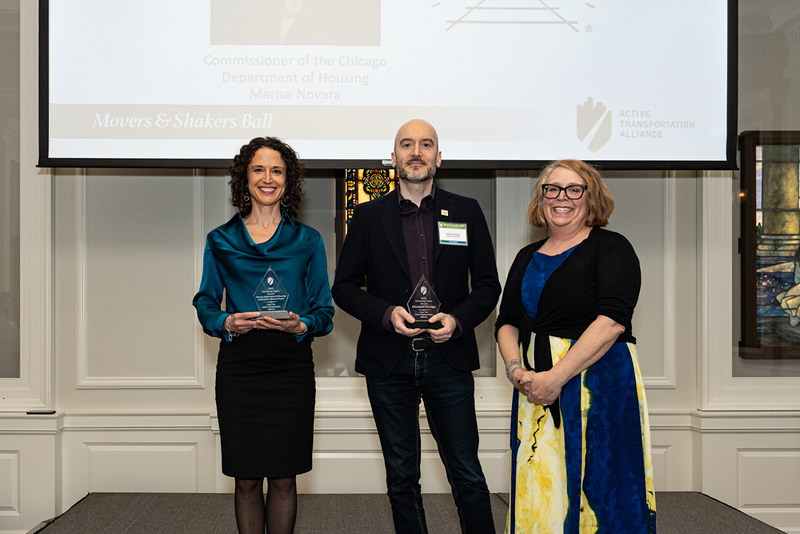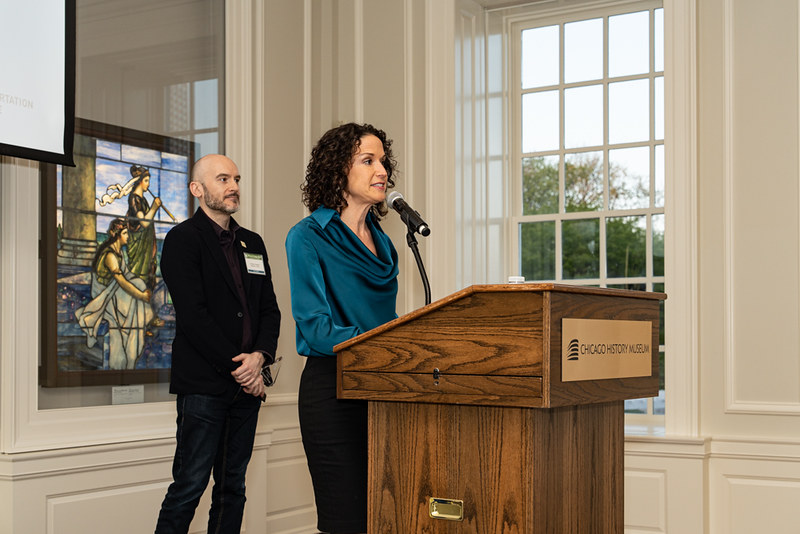Chicago is about to get an influx of affordable housing and businesses around mass transit over the next few years with help from the Connected Communities ordinance, which marks its one-year anniversary this month.
Elevated Chicago joined forces with Chicago Housing Commissioner Marisa Novara to successfully push for passage of this sweeping legislation that addresses racial inequity by catalyzing economic development near public transportation.
Elevated Chicago, a coalition of community organizations, and Novara were recently awarded Active Transportation Alliance’s Equity Award for advocating for the Connected Communities ordinance over the past four years.
Adopted by the Chicago City Council in July 2022, the ordinance advances equitable transit-oriented development, which seeks to create dense, mixed-use, pedestrian friendly communities near transit hubs using equity as a guiding framework.
Active Transportation Alliance was one of the organizations that helped gather support for the ordinance within Chicago City Council.
ETOD intends to transform low-income neighborhoods into thriving, dynamic areas by investing in affordable housing and businesses around public transportation, enabling residents to connect to jobs, schools, services and recreation without cars.
The City of Chicago has had a transit-oriented development policy since 2013. But 90 percent of the TOD projects built between 2013 and 2019 was concentrated in wealthier areas of the city, including the North Side, downtown, and the West Loop, according to the Metropolitan Planning Council.

The Connected Communities ordinance builds on the city’s TOD policy by focusing on equitable development across Chicago and preventing displacement of minorities, according to Elevated Chicago and Novara. That includes bringing TOD to disinvested communities in the South and West Sides of the city, reducing barriers to moderate-cost housing in affluent and gentrifying neighborhoods, prioritizing sustainable transportation infrastructure, and building more affordable housing in all neighborhoods.
“We told the city [TOD is] an example of a policy that in theory looks great, but because it did not use a racial equity lens, it was counterproductive,” says Roberto Requejo, executive director of Elevated Chicago.
“Equitable transit-oriented developments provide people with access to consistent and reliable transit systems,” Novara says. “ETODs make opportunities easier to reach and livelihoods easier to improve. It is a big part of how we get more equitable outcomes by race and income across this city.”
COMMUNITY ENGAGEMENT
The Connected Communities ordinance recognizes that Chicago’s neighborhoods are too diverse for a one-size-fits-all solution. That’s why the law encourages the City of Chicago and developers to work with residents in carrying out TOD projects to ensure the development meets their specific needs.
It includes not only gaining residents’ input prior to the project but also engaging them throughout the project — promoting equitable, responsive, and transparent decision making and investment.
Requejo points to the ETOD project at 63rd Street and Cottage Grove in Woodlawn as a pioneering example of authentic and effective community engagement that benefits residents.
The developer, Preservation of Affordable Housing, worked with the residents of this South Side community to co-design a mixed-use development adjacent to the Cottage Grove Green Line CTA train station.
With residents providing ongoing feedback as an integral part of the design process, the developer built high-quality, functional housing units; communal spaces; commercial space for ground-floor retail businesses; and an enclosed pedestrian walkway that connects the building to the CTA station.
In addition, residents collaborated with the developer to bring Daley’s Restaurant, Chicago’s oldest restaurant, to the development. The fabled restaurant, whose origins date back to 1892, is an institution in Woodlawn that residents want to preserve.
“We want developers to co-design with the residents,” Requejo says. “So it’s not just the residents giving input. It’s that the two are co-developing, co-building, collaborating to reflect what the community has been asking for a long time.
“There isn’t a single community in Chicago, especially these disinvested communities, that hasn’t done tons of planning, tons of research, tons of community engagement showing or telling others this is what our community needs,” he adds.

PAVING THE WAY TO EQUITY
Other critical provisions of the Connected Communities ordinance include more than doubling the amount of land eligible for ETOD. These developments can now be built within a four-block radius of train stations and a two-block radius of high-frequency bus corridors.
The new ordinance also enforces parking maximums. Under the previous TOD policy, developers were allowed to build one parking space per housing unit.
The new ETOD provision only allows one parking space for every two units. By capping the amount of parking for high-density apartments near mass transit, residents don’t have to pay to store cars that they will be less likely to use, lowering development costs and, therefore, lowering the rents and purchase prices of these units.
Another significant provision of the Connected Communities ordinance prevents de-conversion in high-income parts of the city. Affordable multi-unit buildings cannot be converted into expensive single-family homes without a zoning change.
In addition, the ordinance incentivizes developers of buildings with two to six units to create one or more accessible units on the ground floors of their buildings for people with disabilities. If they do build these accessible units, developers are allowed to construct additional units in their buildings that the zoning code would otherwise prohibit.
“So there’s a ton of those provisions [in the Connected Communities ordinance]. None of them alone can change [a community] dramatically,” Requejo says. “But when you apply them all together — developers building more accessible units in one neighborhood, others that are building less parking, others that are using provisions to reduce development costs or increase the number of affordable housing units — when everybody across the city uses them, now you see the impact.”
PRODUCTIVE PARTNERSHIP
While getting the Connected Communities ordinance passed was a huge win, obtaining the funding for the ETOD projects was just as important, according to Requejo.
Novara played a crucial role in allocating $800 million from federal housing tax credits toward ETOD — the largest amount in Chicago history. The money will fund affordable housing for 18 ETOD projects: 12 in the South and West Sides and six in gentrifying communities.
Novara, who recently announced she is stepping down as the city’s housing commissioner, dedicated much of her four-year tenure to championing affordable housing and combating segregation in Chicago. That commitment made her the ideal ally to collaborate with, according to Requejo.
“Although many city departments played a role [in supporting the Connected Communities ordinance], I want to credit the Department of Housing and Commissioner Novara for accepting Elevated Chicago’s offer to be their partner,” Requejo says. “When we started this journey several years ago, we offered the city our table to define together with the community what ETOD meant, to build jointly the visions of our community partners and to keep the city accountable to the promises they made. And DOH and [then-Mayor Lori Lightfoot’s] office embraced all of it and never gave up in spite of the strong opposition to the most progressive provisions of the ordinance. The result is an ordinance that is positioning Chicago as a national leader in equitable transit-oriented development.”
Photos of Novara (top), and Requejo (second down), and the the two with Active Transportation Alliance Executive Director Amy Rynell were taken at our Movers and Shakers Ball in April.

